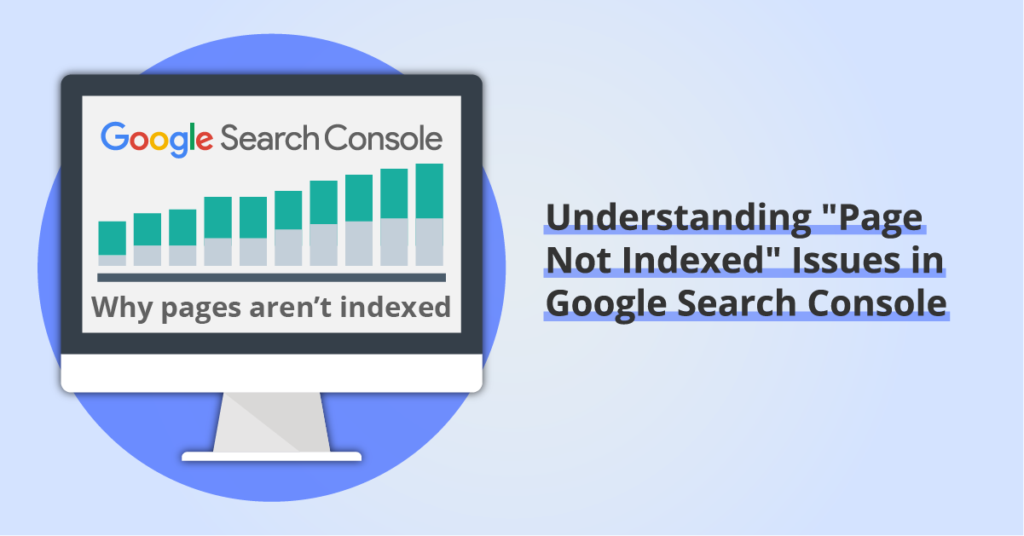SEO Keywords for Squarespace: How to Research and Use Keywords
By: Ed Harris / Published: June 21, 2021 / Last updated: June 28, 2024
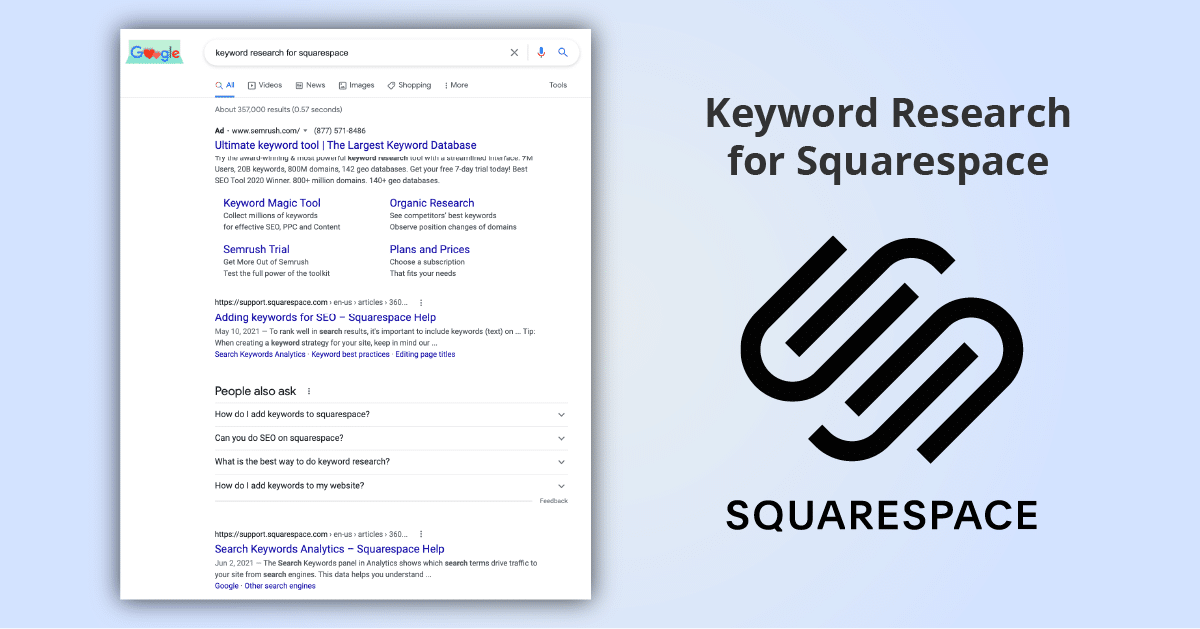
Understanding how to find and use keywords is essential for increasing your Squarespace website’s search visibility. In this guide we explain the following steps to help you get started:
- What makes a good keyword
- Criteria for a good SEO keyword
- 3 free keyword research tools
- 2 affordable paid keyword research tools, in case you want to level up 🙂
- How to add keywords to your Squarespace website
- How to track your keyword rankings in Google search results
This guide is part of our series on search engine optimization (SEO) for Squarespace website owners. Follow these links for more detail about Google Analytics, Google Search Console, and accessing your Squarespace sitemap.
Disclosure: some of the links below are affiliate links, meaning that at no cost to you, we will earn a commission if you click through and make a purchase. Learn more about the products and services we recommend here.
What are keywords and how do they help with SEO?
First let’s cover the basics. When we talk about SEO keywords, what do we mean?
A keyword is essentially just another word for a “search term” or “search query” — something a user has typed into a search engine like Google. Of course, people don’t just type single words into Google. Often a search query will consist of a series of words, or even a full sentence. For this reason you may read about “keyphrases” as well as “keywords” for SEO. In this guide we’ll refer to keywords. Just remember that a keyword can also be a phrase or a sentence!
Developing a keyword strategy is one of the most important aspects of SEO. This means getting into the habit of thinking about keywords, researching keywords, and working keywords into your website content.
Why are keywords so important for SEO?
Because a search engine’s purpose is to help users find what they are looking for. To do that, search engines have to crawl millions of webpages to try and identify the most relevant, high quality content for each search query. One of the ways search engines understand relevance is by looking for the presence of keywords in your webpage content.
Including keywords that match the user’s search query is great. However, search engines are smart enough now to understand the relationships between keywords, so you don’t have to have an identical keyword on your page to demonstrate relevance.
Before we move on, it’s important to note a couple of historical keyword practices that have become outdated and may even damage your SEO efforts:
- Don’t add keywords in a <meta> tag. Years ago when search engines were less sophisticated, you could add a bunch of keywords in a meta tag in the header of a webpage to signal what the page was about. In brief: this isn’t a thing any more. Squarespace doesn’t even include a space to add keywords to the header. So ignore this if you come across outdated advice about a keywords meta tag!
- Avoid “keyword stuffing.” This refers to the practice of adding as many keywords into a webpage as possible. This is another outdated practice that used to have a positive impact on search rankings but will now result in your webpage being penalized by Google.
Remember: overall search engines will reward high-quality, relevant content with higher search rankings.
3 criteria for a good keyword
Now let’s define what makes a good keyword for you to target. We’ve already covered the first factor:
- Relevance. Search engines are trying to match user queries with relevant content. Don’t try and rank for a keyword that is not relevant to your business’s services or the other content on your website.
We can use the second and third factors to narrow down the pool of potential keywords and decide which ones to focus on.
- Volume. This means how many search engine users are searching for this keyword (often expressed as searches per month). The logic here is that it may not be worth optimizing for a keyword that very few people are searching for. And conversely, there might be a lot to gain if you can win a top search ranking for a high-volume keyword.
- Competition. This factor involves looking at what other websites are competing for the top search rankings for that keyword. If the top search rankings are already occupied by pages from large, authoritative websites, a smaller website may not have a realistic chance of breaking into the top search rankings. It’s worth thinking about who you will be competing against.
The trick here is to find relevant keywords that fall in the sweet spot of medium-to-high volume and low-to-medium competition. If you can find a keyword that has 1,000 searches a month and you feel confident you can develop a high-quality webpage to answer that query than the pages you currently see in the top rankings you’ve found yourself a great keyword!
A quick note here about “long tail keywords” before we move on. Often to find keywords in that sweet spot, you have to focus on “longer tail keywords”. This refers to keywords that are often more than just 1-2 words, and are more narrow and specific. Search volume for longer tail keywords is often lower, but you may have an easier time breaking into the top search rankings because competition is also lower.
Now let’s review some options for conducting keyword research.
Free keyword research tools
If you just want keyword suggestions and ideas there are several free tools that will get you started. Note that none of these tools provide data about the volume of searches or the competitiveness of the search results rankings.
However, the fact that a keyword shows up in one of these free tools is an indication that there is at least some historical search volume. And you may be able to get a rough gauge of the competition by opening up an incognito or private browsing window, entering the keyword into Google, and reviewing the webpages that show up on the first page of results.
Google Autocomplete
The first tool on our list is Google itself! You can take advantage of Google’s autocomplete suggestions by starting to type a basic keyword into the search bar and waiting to see what suggests are autocompleted before you submit the search.
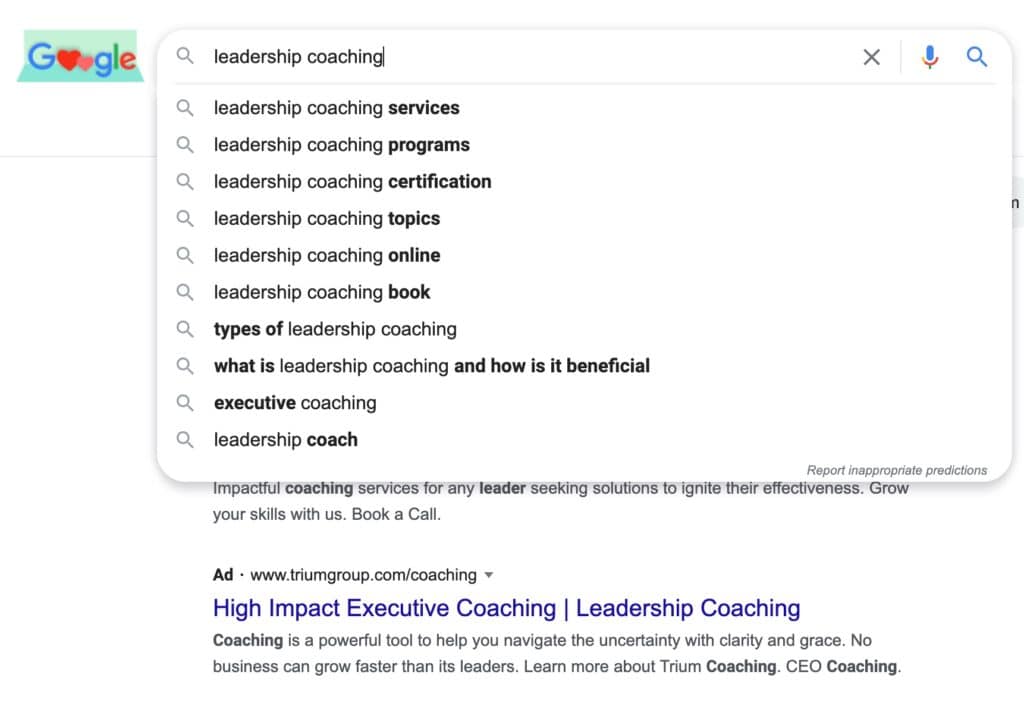
You can also try a base keyword followed by each letter of the alphabet to generate some more variety of suggestions.
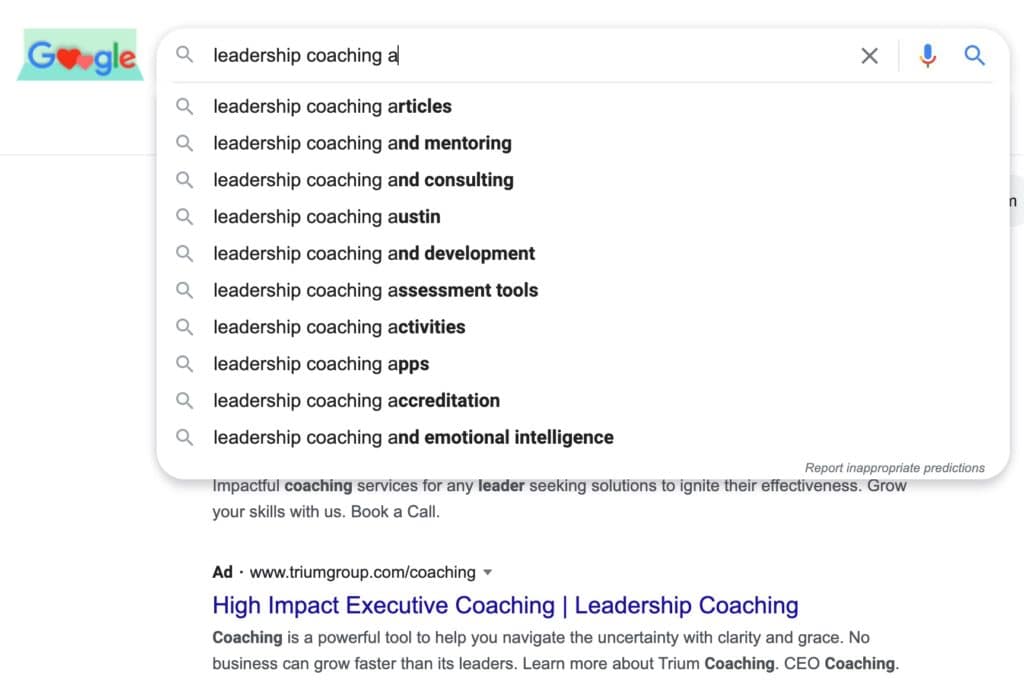
Make sure you do these in an incognito or private browser window so your own profile and search history doesn’t influence the results.
You can also check out the “People Also Ask” and “Related Searches” features on Google search results pages to gather more related keyword ideas:
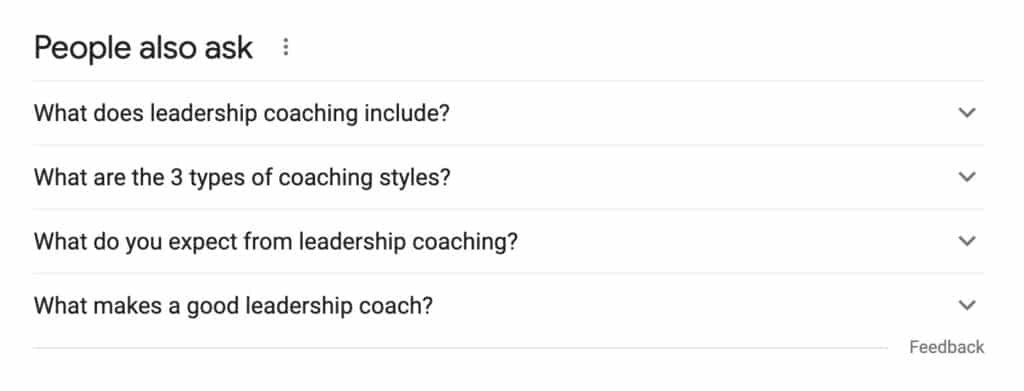
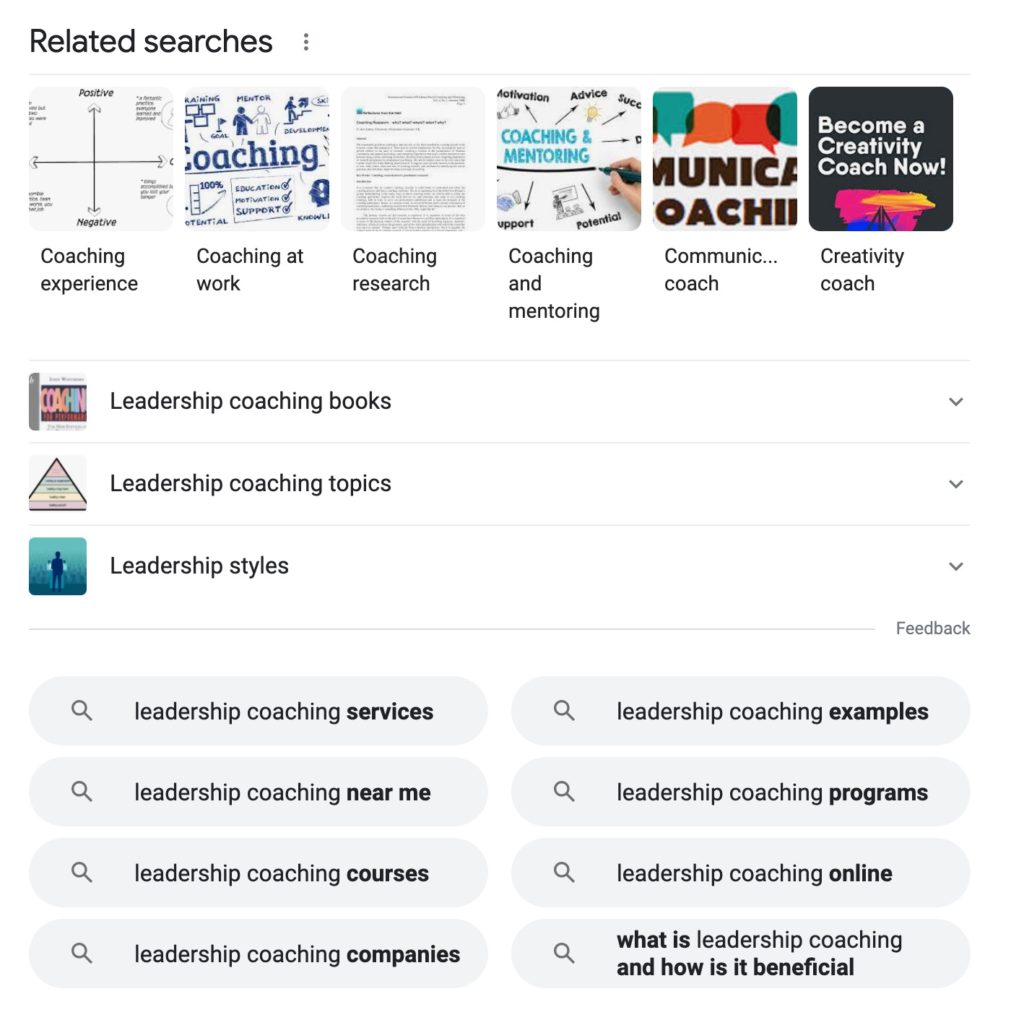
Make a list of any keywords that look like they might be a good fit for your website. Then go check out the search engine results page for those keywords and see what the competition is like.
Keywordtool.io
The website keywordtool.io offers a shortcut to some of the ideas you can surface from Google Autocomplete. The free version offers lists of suggestions for related keywords, as well as keywords in the form of questions, and keywords that include prepositions. Be warned, the site will tease you with blurred out volume and competition data!
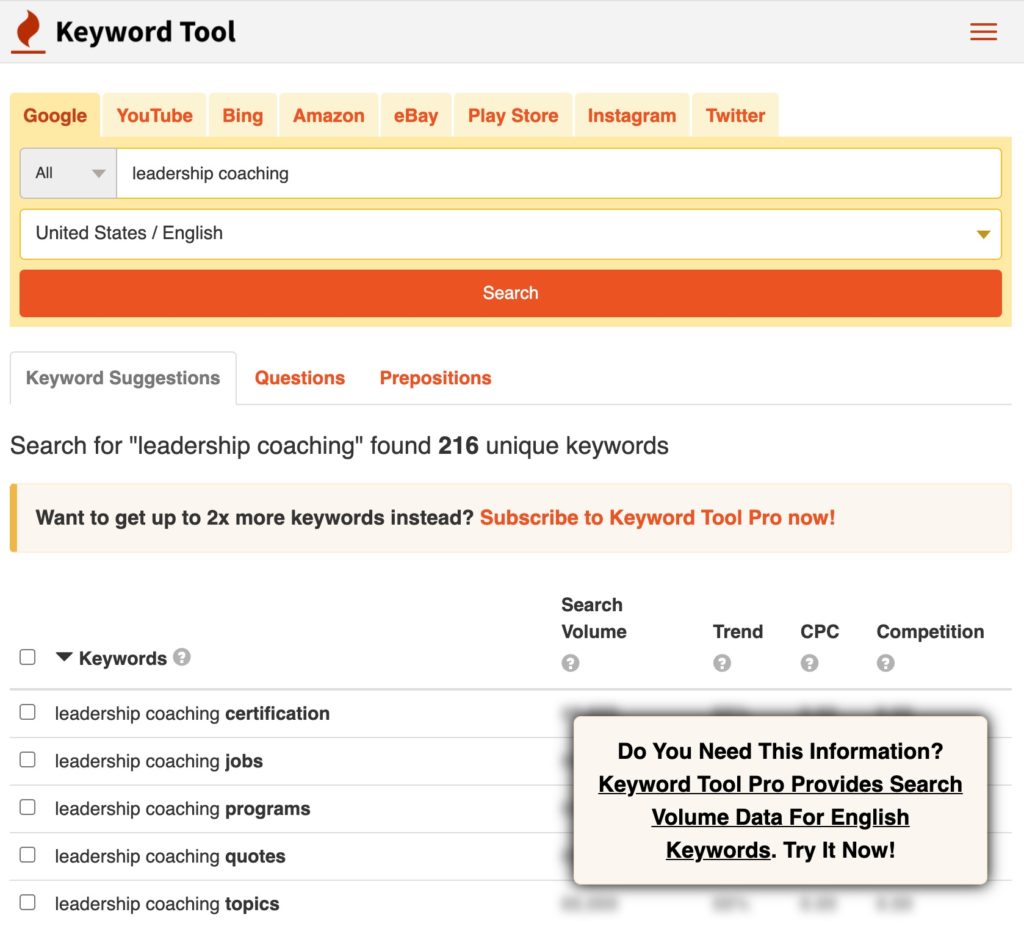
Google Search Console
Google Search Console is a powerful free tool that provides data about which pages from you website are being shows to Google search users for specific queries. You can use Search Console to identify which search terms your website is already ranking for and then work on optimizing your content to get higher positions in the search rankings. To learn how to set up Google Search Console for your website check out this guide and video.
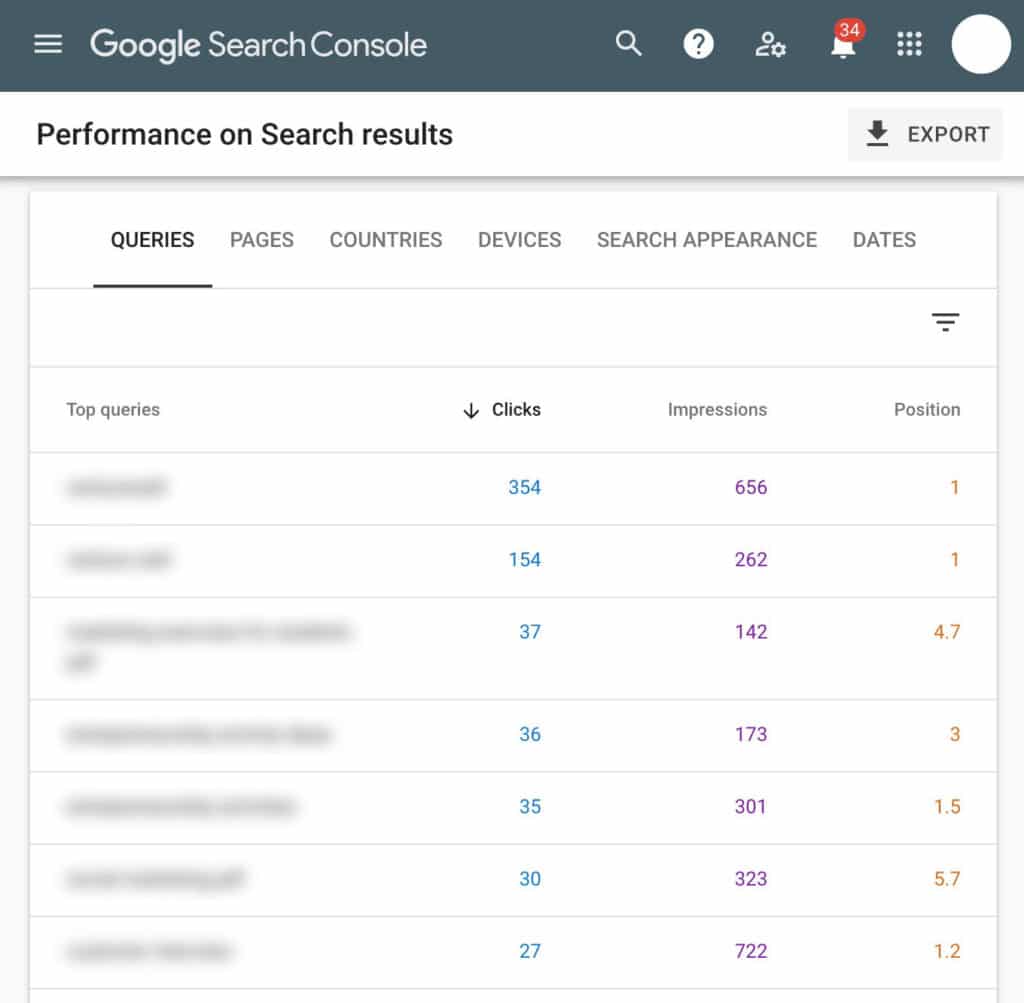
Affordable keyword research tools
In addition to offering lists of related keywords like the free tools above, these tools offer keyword volume and competition data at affordable prices.
Keywords Everywhere
Keywords Everywhere is a paid browser extension for Chrome and Firefox that provides search volume and competition data for keywords as you enter them into Google.
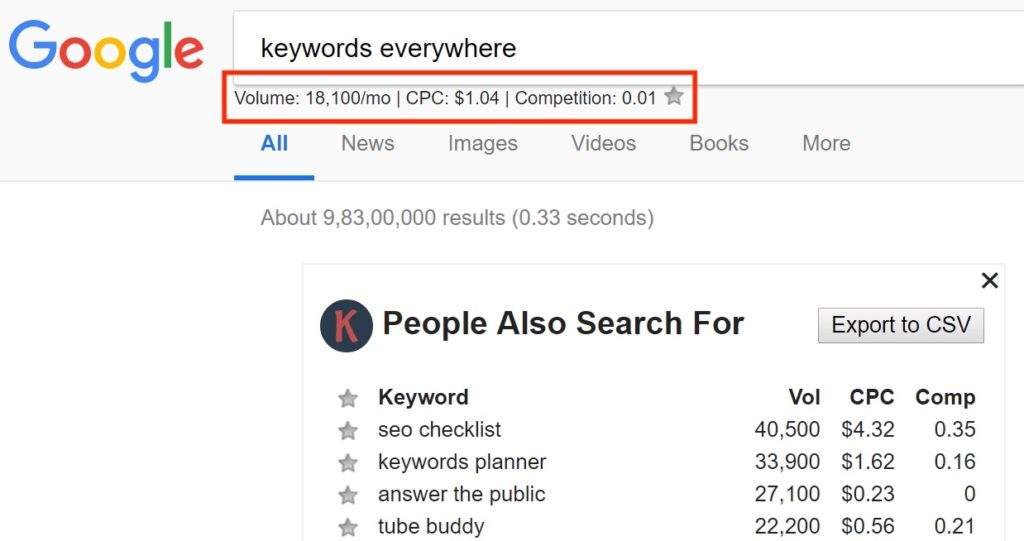
The pricing is based on credits that apply to the number of searches you use. Credit packs start at $10 for 100,000 keywords.
Wordtracker
Wordtracker provides a similar service to Keywords Everywhere, displaying valuable data about keyword search volume and competition. Wordtracker offers a free trial and several free searches allowing you to test out the functionality, and pricing for paid plans starts at just $17/month.
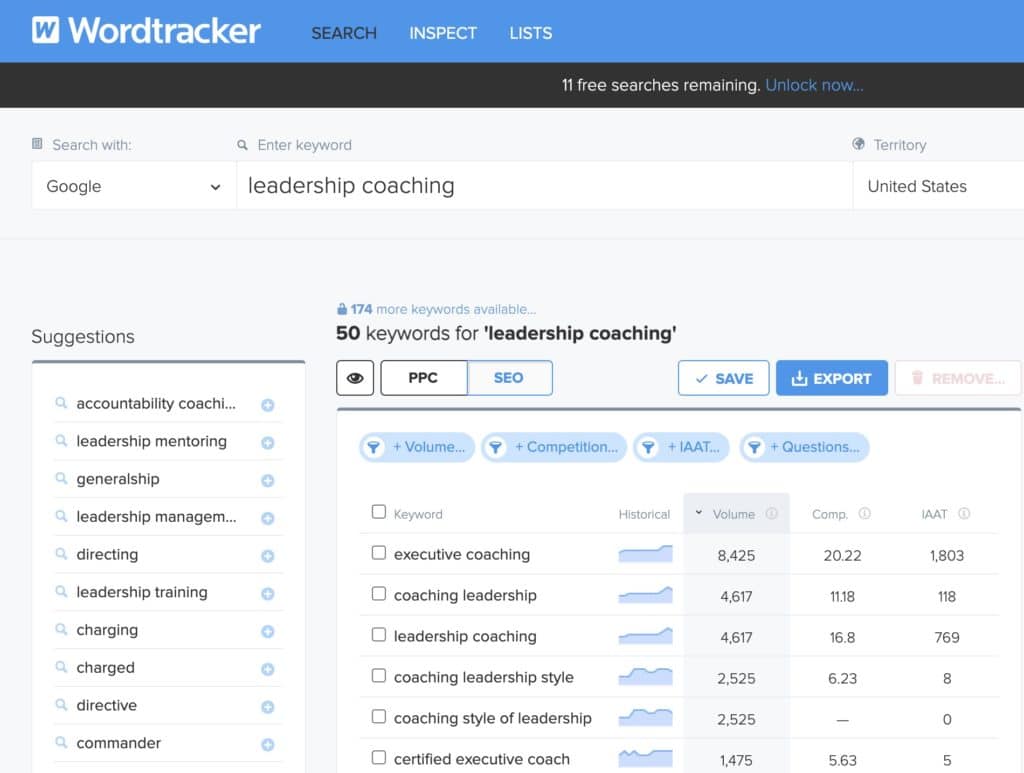
Take Wordtracker for a test drive here.
How to add SEO keywords in Squarespace
Once you have identified a list of keywords to target, refer to this list of 9 places where you should consider keyword use as you develop and optimize content on your Squarespace website.
1: Site title
Your site title will usually include brand name or the name of your business, but this is still a good opportunity to indicate a keyword for the entire website. To edit the site title tag in Squarespace 7.1, go into editing mode on any page on your site, hover over the header and click the button to “edit site header.” From the list of global elements, select “Site Title and Logo.”
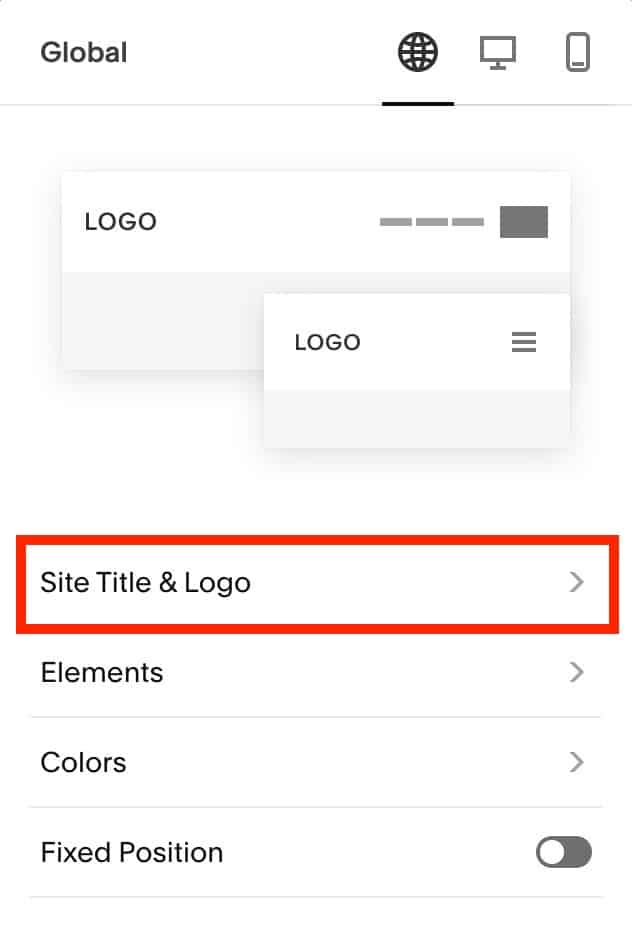
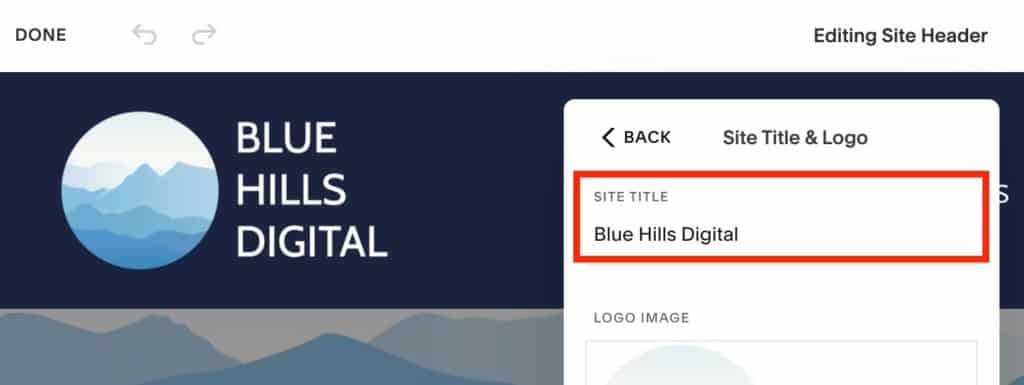
2 – 4: Page Title, Navigation Title, and URL Slug
Items 2 to 4 should be optimized for each individual page on your website.
These three options can all be access from the “General” tab of the Page Settings menu. The page title and navigation title offer opportunities for consistency in reinforcing a short version of the page title that includes the target keyword.
Similarly, the URL slug should be short and include the target keyword, with words like “and” removed and hypens between words.
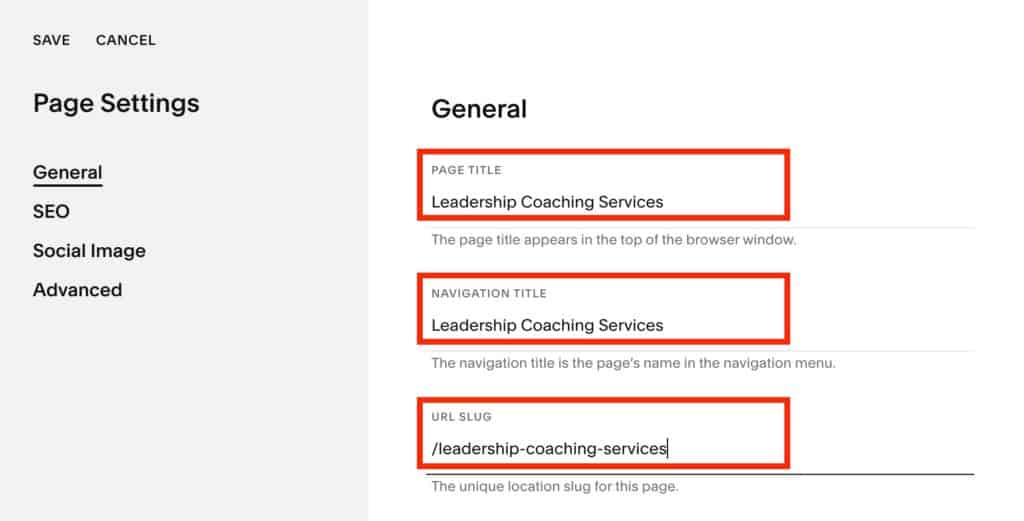
5 – 6: SEO Title and SEO Description
Items 5 and 6 control how the page is displayed in search engine results.
The SEO Title will default to the Page Title but can be modified if necessary.
The SEO description is a great opportunity to provide a short, keyword optimized description of the value the page delivers. This is your chance to help persuade search users to click through to your website if they see your page in the search results.
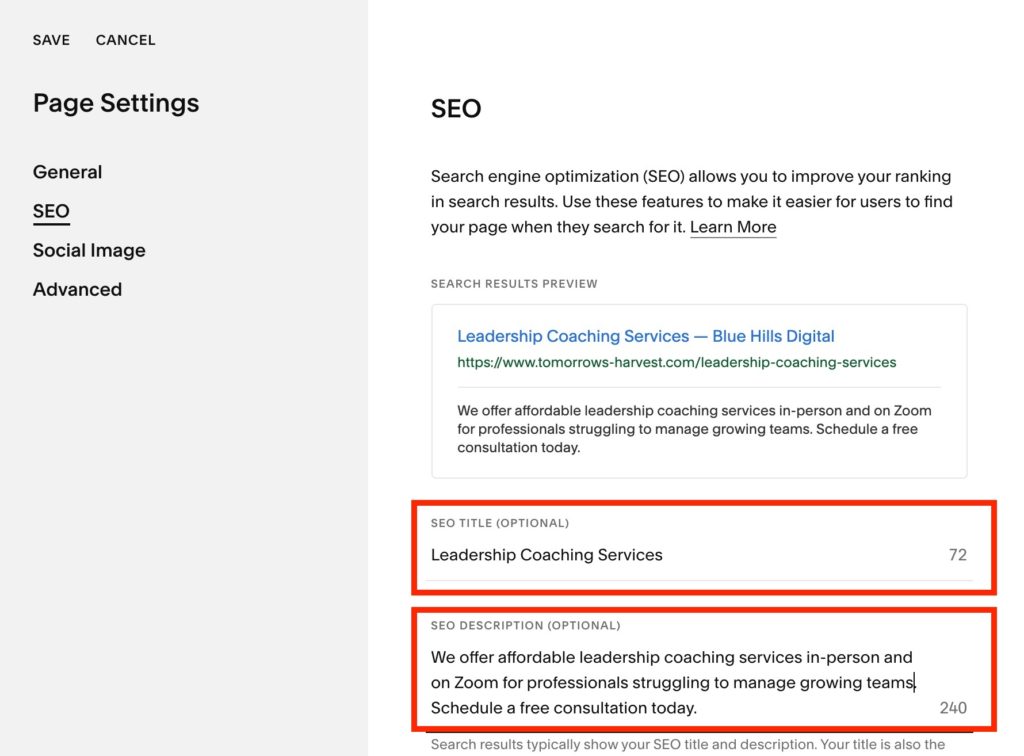
7 – 10: H1-H3 Headers, Body Text, Links, and Images
Items 7 to 10 are areas to optimize within the body content of each page.
Headers: Each page should just contain one Heading 1 tag which will be the page title as displayed to the user.
Subsequent sub-headings should use a logical structure of Heading 2 and Heading 3 tags. These sub-headings are good opportunities to include secondary keywords that are related to the target keyword, such as related questions.
Body Text: Google will crawl all of the content of a page, so it’s important to review and optimize the body text of you webpages too. Make sure you include your keywords in the body copy (without overusing them in a way that makes the content unnatural to read).
Links: Make sure that your pages contain links to relevant internal and external resources related to your keyword. Make sure to actually use the keyword in the anchor text of the link (instead of using non-descriptive text like “click here”).
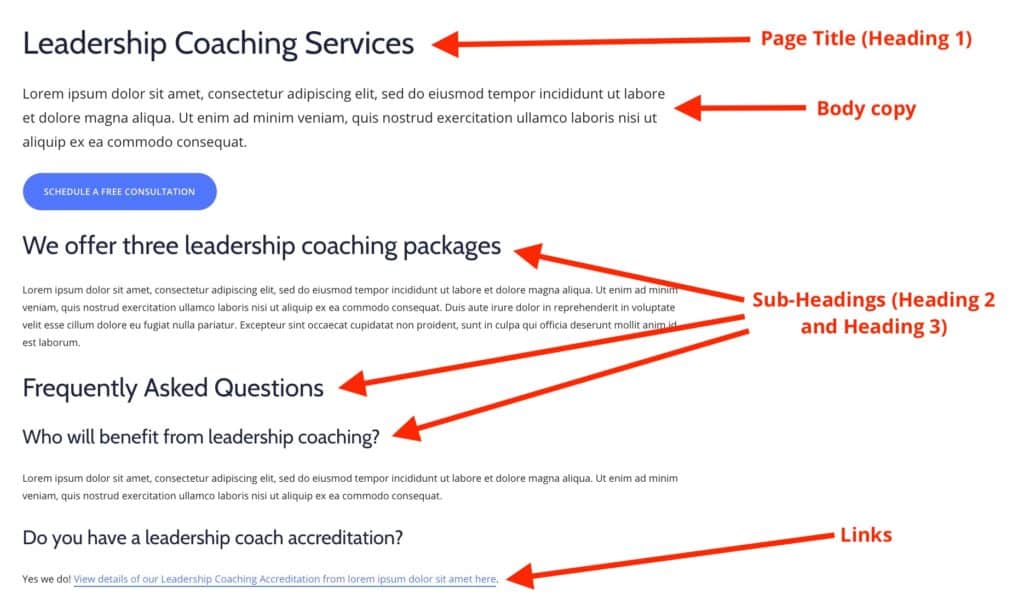
Image Alt Tags and File Names: Every image on your website will have a file name that is visible to search engine crawlers, and every image should also have alt text. Remember: Squarespace uses the image caption as the alt text, so you need to enter a caption in order to set the alt text field, even if you then choose to hide the caption in the “Design” tab. Both of these are additional opportunities to reinforce the keywords that describe the content on the page.
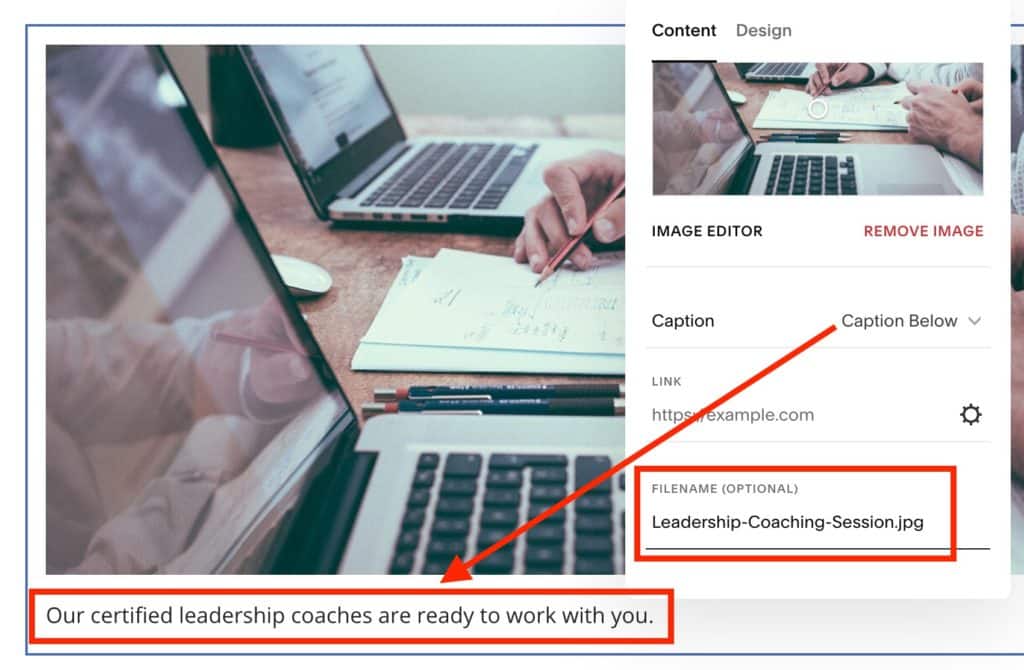
How to track your SEO rankings
Once you start investing some time and effort into a keyword strategy for SEO, you will probably want to start tracking your results!
As we mentioned above, Google Search Console is a great free option to track your organic search rankings. This is a powerful tool that provides data about which pages from your website are being shown to Google search users for specific queries. It also includes data about how many users clicked through to your website, the click-through rate, and your webpage’s position in the search engine results page. Check out our guide and video to setting up Google Search Console for your Squarespace site.
If you want to actively track the position of a specific set of keywords that you have deliberately chosen to target them you may want to invest in a paid keyword position tracking tool. We use SEMrush with our clients, and we recommend it! Sign up for a free trial of their Pro plan here.
Conclusion: Remember your website visitors are real people!
With all the keyword data about volume and competition and ranking positions, it can be easy to forget that we’re still developing website content for real people.
If you find yourself stuck in your keyword research, step away from the data and put yourself in the mindset of one of your customers. When they have a problem that your business could solve, what would they be likely to type into Google?
Have fun with your keyword research: it’s a great opportunity to get inside your audience’s minds and get better at answering their questions!

